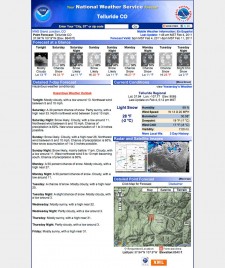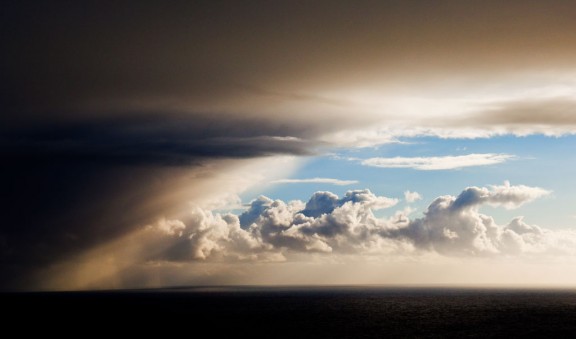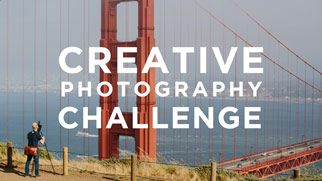[Scott here…and welcome to the second post in a series of three discussing the steps we take in selecting and scouting locations for our most important photo and video shoots. In the first post in this series we discussed the process of narrowing in on your locations with computers….”virtual scouting”. Now we’ll tackle something a bit less concrete…that great mystery in the sky…no I’m not talking about God, I’m talking about the WEATHER.]
The weather can be the photographer’s best friend or worst enemy. I can think back on days of perfect powder and blue skies when we nailed a heli-skiing weather window while shooting for REI. I can also think back on being cooped up in a hotel in Chile for weeks on end, waiting for unceasing rain and wind that made outdoor photography a complete impossibility.
Suffice to say, we’ve learned through many years of shooting outside that there is no way to predict or control the weather, but that there ARE a lot of ways to stack the deck in your favor. You might even say that we’ve developed a set of rules, and if we follow these rules closely enough, we can usually keep our boots clean and our rain jackets in the car. Today, I’d like to share these secret rules with you. Click ‘continue reading below’…
Rule #1 – Pay attention to the climate of your prospective location. “Climate is the average weather conditions at a particular place over a long period of time. Climate is the long-term predictable state of the atmosphere. It is affected by physical features such as mountains, rivers, positioning of the globe, plateaus, deserts, depressions and much more.” (Definition from the Global Energy Initiative Glossary). Even in reasonably consistent climates like Hawaii the difference between the rainy season and the dry season can have a massive impact on not only the day to day weather but also the vegetation, clarity of the water, air quality, etc. Also pay special attention to the second part of the definition regarding the effect of physical features. We have a mountain range running down the center of Washington state that creates rain forests on one side and desert on the other. Know and understand these micro-climates. You can use this knowledge to your great advantage.
As it is to everyone’s benefit to understand the climate in order to predict the weather, there is a wealth of information on climate available online. Here in the USA, the best source I’ve found is the National Climate and Data Center.
http://www.ncdc.noaa.gov/oa/climateresearch.html – This is a huge source for long term climate information. If you want to find out the average temperature or precipitation for April 20 in Palm Springs over the last hundred years, this is your place. The data is primarily focused on the US, but there is good global information as well. If you live outside the USA, your home country likely has a similar service.
Rule #2 – Keep current on your most important locations. As a location research specialist and a weather nerd I get enjoyment from keeping tabs on the weather even when we’re not about to produce a location shoot. I have an understanding of what’s been happening this year in the mountains of the American west, the cities of the east coast, even the summer weather in New Zealand. By casually watching your “hot zones” throughout the year [see my earlier post here on our favorite places to produce location shoots throughout the world…], you’ll be ready with recommendations as soon as your client comes to you with a certain need.
Rule #3 – Use multiple sources to help with your accuracy. Here in Western Washington we live in a famously difficult forecast area. To the west we have the great Pacific Ocean bringing constantly changing weather. To the north we have powerful systems from Alaska, to the South we get tropical blasts from the middle latitudes, to the east a rugged mountain range serves to mix up all of these influences into a dynamic gumbo of weather. On the same day you’ll read forecasts from 6 different sources that are often quite different, and hilariously all sorta correct in their own way. For this reason I’ve grown accustomed to monitoring a broad range of forecasts and finding good accuracy by averaging the results. If four of the six forecasts say that there will be 4-6 inches of snow, the odds are probably pretty good. You can probably throw out the one forecast calling for 18 inches. Here are a few of our favorite sources that will also serve YOU well:
 http://www.accuweather.com – This site has been renamed “optimisticweather.com” around here because it seems to always look on the bright side of life. I don’t use it because it’s accurate (it’s not very accurate). I use it because their forecasters are brave enough to forecast 15 days out. It’s not uncommon for the beginning of a shoot to fall into this two-week timeframe, so accuweather can give some idea of the weather we might actually see when we arrive on location.
http://www.accuweather.com – This site has been renamed “optimisticweather.com” around here because it seems to always look on the bright side of life. I don’t use it because it’s accurate (it’s not very accurate). I use it because their forecasters are brave enough to forecast 15 days out. It’s not uncommon for the beginning of a shoot to fall into this two-week timeframe, so accuweather can give some idea of the weather we might actually see when we arrive on location.
http://www.nws.gov – This is the home page of the National Weather service. My favorite feature is the map which you can use to get pinpoint forecasts for any location in the US. This tends to be extremely accurate, but only gives you a few days worth of forecasts. If you’re based in the US you’ll find almost no end to the amount of weather data on this site; from marine to aviation, deserts to mountains, if there’s weather there, this site has information about it.
http://www.wunderground.com – I’ve found this to be the most consistently accurate commercial weather site and the coverage is worldwide.
http://www.nwac.us – This is the best source for mountain weather in the winter here in the northwest. The avalanche center maintains a vast number of weather stations providing hourly data from the field. NWAC is limited to the mountains of Washington and Northern Oregon, but many mountainous regions have similar avalanche centers providing fantastic data and forecasts.
Ok, those are the three primary “rules”…but let’s not forget the always-important final rule when it comes to weather….
Rule #4 – Be patient, flexible, and light on your feet. You never know what you’re gonna get. If you do get thrown a curve ball, be prepared to hit that ball anyway. In many cases, dramatic weather adds a beautiful, powerful, and unexpected layer of drama to your pictures or video. We’ve had some of our best results from weather that we didn’t predict, so don’t be afraid to shoot your project anyway if you can afford to take the chance.
In the next installment we’ll take a look at scouting once we’re on the ground. Think touristing with zero free time, a few really cool gadgets and tools that you’ll love, a bunch of meetings, and a travel hangover. See you again soon!

























I’m really enjoying the theme/design of your site. Do you ever run into any internet browser compatibility problems? A handful of my blog readers have complained about my website not working correctly in Explorer but looks great in Opera. Do you have any suggestions to help fix this problem?
It’s really a nice and helpful pidce of info. I am happy that you just shared this helpful info
with us. Please keep us up to date like this.
Thank you for sharing.
Easily, the post is definitely the greatest on this laudable topic. I concur together with your conclusions and can thirstily watch forward for your future updates. Saying cheers won’t just be adequate, for the wonderful c lucidity inside your writing. I’ll immediately grab your rss feed to keep privy of any updates. Solid work and substantially success inside your business enterprise enterprise!